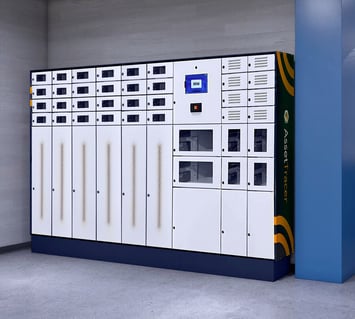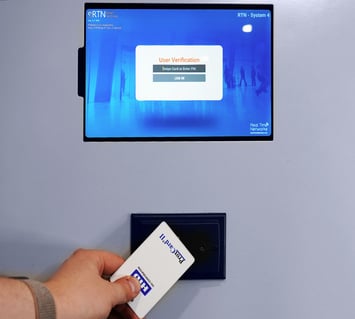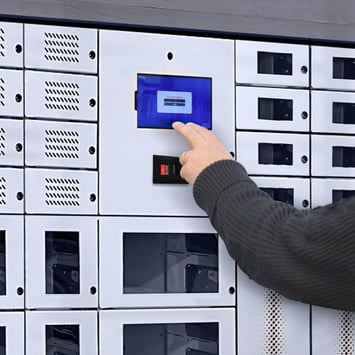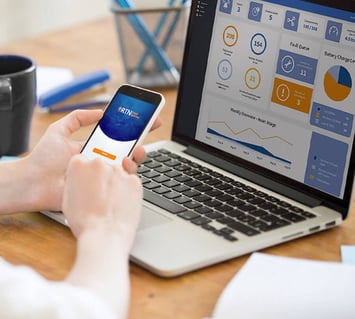By Jay Palter | May 17, 2023
The COVID pandemic upended strategic planning, administrative budgets, and operations at healthcare institutions worldwide. Years later, those institutions still need help finding new, optimal processes to deliver healthcare to communities. Many are considering new technological solutions for their medical equipment and inventory management as a cost-saving measure.
Any new technology must deliver a solid return on investment for cash-strapped healthcare centers. Which technologies are worth investing in, and which don’t deliver on their promise?
One of the most flexible and reliable services you can use is RFID wireless tracking. It streamlines asset transactions and helps automate the time-consuming task of tracking and inventorying medical devices. And it works well in many healthcare settings.
But is RFID the right solution for your institution? This article explains what RFID is, how RFID tracking can help your organization, and how RFID asset tracking in hospitals works today.
What is Radio Frequency Identification (RFID)?
RFID stands for radio frequency identification, a short-range wireless communication standard commonly used in many public and private sectors, including healthcare. RFID tags securely transmit their identity and other important data when placed close to scanners—for example, in the consumer world, with tap-to-pay credit cards.
RFID technology in healthcare is a good choice for medical equipment tracking because it doesn’t conflict with other common business wireless standards. For example, WiFi internet, Bluetooth, and Zigbee device communication standards work perfectly fine alongside RFID.
It offers other important benefits too. For example, RFID doesn’t require line-of-sight to work. Signals can pass through drywall, plaster, plastic, and other common building materials in healthcare settings, so they work even in crowded patient rooms. In addition, scanners can read separate tags inside a scanned medical kit, hard case, or other containers. However, it is important to know that metal reflects RFID signals, so it might not be the best choice in some medical rooms with many metal surfaces.
How Do Healthcare RFID Hospital Inventory Management Systems Work?
Hospital inventory management systems are powerful, flexible technologies that hospitals and other healthcare providers can easily customize to support and improve their work. They fit neatly into established medical workflows by automating and enforcing tight process control over what are otherwise tedious manual tasks.
While installations will differ across healthcare venues with different use cases, RFID tracking systems are always built from a few essential core components: storage cabinets, RFID tags, readers and access terminals, and management software.
Storage Cabinets
RFID hospital inventory management systems may be advanced, smart technology, but they must still be built on top of secure, reliable storage cabinets. These hold keys, expensive medical devices, medical kits, and other important equipment when nurses and technicians aren’t using them. In addition, cabinets often include charging ports to ready electronic medical devices and data cables connected to an onboard operating system for fault monitoring. So you won’t be left to discover a critical device has stopped working right when you need it the most.
Advanced hospital inventory tracking systems are modular, meaning you can stack and configure them for different units. For example, your ICU may want to track where each resuscitator is in use. And your maternity ward may want to track fetal stethoscopes, scales, and other critical neonatal equipment.
Learn More: Hospital Medication Security: A Guide to Protecting Controlled Substances

RFID Tags
Healthcare centers use a combination of passive and active RFID tracking tags. Passive tags do not have an onboard battery. Think of the small RFID chips embedded in credit cards. They transmit their identity when someone brings them close to an RFID reader on the exterior of a storage cabinet. They’re effective at tracking smaller, handheld equipment at signout and return.
Active-powered RFID tags with a built-in battery are also available. They have a greater range but are also bulkier and more expensive, making them suitable only for tracking mission-critical and expensive medical devices.
The tags are usually attached to or embedded in equipment. For medical facility keys, that typically takes the form of an RFID fob attached to the key ring that doubles as the locking mechanism in the storage cabinet. Tagging varies much more with equipment and kit items. Some electronics, like radios, mobile devices, and handheld scanners, come with embedded RFID tags or a fob slot where you can add one. With other equipment, you need to attach the tag to the exterior.

RFID Readers
RFID readers emit a harmless radio signal that bounces off nearby tags when they’re in range. That signal returns identity data the reader can analyze to track the tagged item’s location and use. These scans take a fraction of a second, and readers can scan multiple tags simultaneously. Most systems for RFID asset tracking in hospitals will have a reader mounted on or near the storage cabinets so your nursing and technical staff can scan items as they take or return them.

Access Terminals
The access terminal on the front of the storage cabinet is your staff’s primary interface with the hospital asset tracking system. Users authenticate themselves at the terminal when they want to sign out or return a stored item. In addition, access terminals can utilize one more access control method, such as swipe cards, PIN codes, or biometrics, such as fingerprint, iris eye scan, or facial recognition, for controlling access to especially-important assets.
Advanced healthcare equipment tracking systems use touchscreens for access terminals to provide customized checklists. This is one of the key ways RFID in hospitals can improve process controls. For example, when a technician signs out instruments to repair medical equipment, you can prompt them to verify that it is calibrated properly. If they don’t answer, the technician’s supervisor receives an immediate email warning them that the equipment may not be properly repaired. This helps you avoid medical errors and costly misdiagnoses.

Management Software
Data from the RFID readers, cabinets, and access terminal all flow back to a software management dashboard that nursing supervisors and medical directors use to get real-time tracking data on RFID-tagged equipment and keys. Modern software dashboards are designed as web apps. So they’re accessible from any institutional device, like authorized desktop computers at the nursing desk or smartphones and tablets carried on the unit floor.
Through the dashboard, your administrators can receive real-time tracking alerts if keys or equipment are overdue for return. They can also generate reports that show them detailed tracking histories so they can help identify meaningful trends you might not see otherwise. That helps you monitor employee performance, ensure accountability, and improve compliance with important healthcare regulations.

How Can RFID Tracking Systems Improve Hospital Operations?
RFID asset tracking in hospitals improves healthcare in many important ways.
They reduce costs
RFID medical equipment tracking systems can save your staff hours of labor every week by automating tedious, manual management. For example, the RFID tracking system will automatically compile everything you need to know about who signed out which medical devices, when they’re due to return to central inventory, and if there are any issues.
Those hours will quickly add up and offset the upfront costs of an RFID tracking system. That is before any operating efficiencies you’ll gain. For example, managers won’t spend as much time overseeing asset transactions and monitoring reports.
Standardize critical medical workflows
Smart medical equipment tracking systems do more than just monitor the medical devices they store. They offer important insights into the care your staff provide with those devices. Better tracking will help you automate and standardize critical medical care so that procedures and testing are carried out consistently, reliably, and with good feedback when errors occur.
Improve employee accountability
Systems for RFID asset tracking in hospitals enforce better accountability among staff signing medical devices in or out. Every transaction your nursing staff and technicians make is recorded. The system also records the condition of everything signed out. For example, for digital devices, are they fully charged? Did the user report any fault codes or other issues with the device at sign-out or return?
If they report any fault codes, the system sends an instant alert to technicians and pulls the device from circulation. In addition, the storage locker will only unlock for a technician taking it for servicing, so there is no risk that faulty equipment will be used in patient care.
Automating equipment and key management also reduces the opportunities for staff to lose vital equipment. For example, suppose a staff member is ever late returning a medical device from a patient’s room. In that case, the system can send an immediate alert to their nursing supervisor so they can track it down and get it returned to circulation.
Generate new process efficiencies
Your efficiency rates will increase when you know precisely where critical medical equipment and mobile devices are at any time, who signed them out, and when they’re due for return. You won’t waste time hunting for missing equipment.
Discover the Power of RFID
See how RFID tracking systems work, how they’re used in different industries today, including healthcare, and some best practices for adapting them to your center’s care practices.
Subscribe to our blog

Jay Palter
Vice President of Marketing & Partnerships




